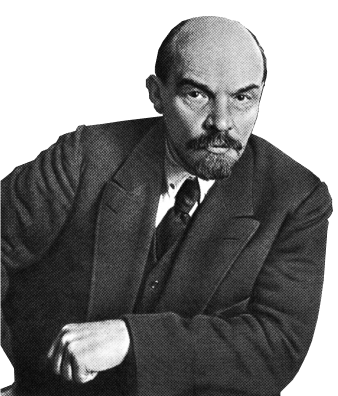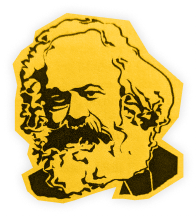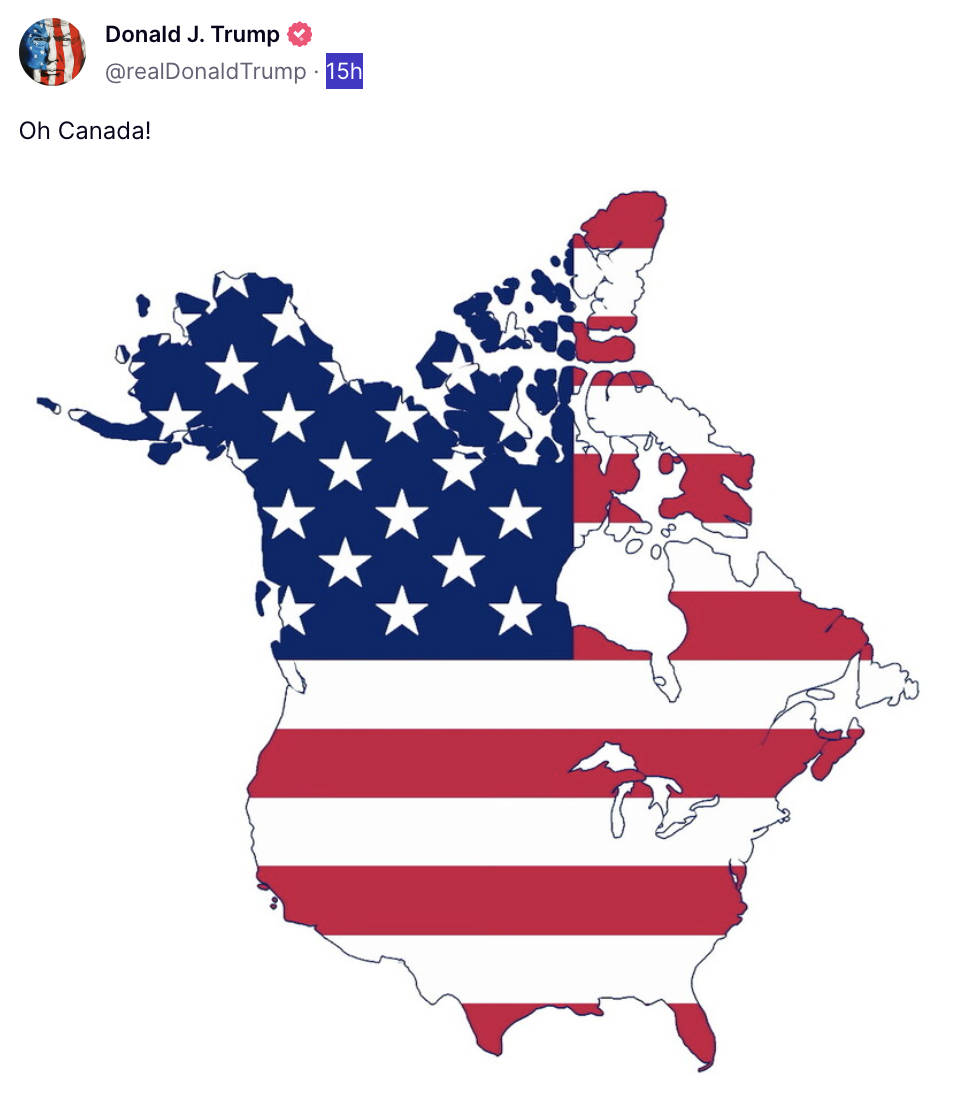
The newly elected president of the United States, Donald Trump, has repeatedly threatened to annex Canada over the past several weeks. While initially written off as a joke by Canadian officials, the thrust behind Trump’s threats has dire implications for Canadian capitalism.
Trump’s comments about Canada becoming the 51st state came in the context of Trump threatening to impose 25 per cent tariffs on exports to the U.S., which would be devastating for the Canadian economy. These threats provoked an immediate panic in Ottawa and all the provincial capitals across the country.
Initially, Canadian politicians across the political spectrum all tried to appease Trump, but this failed as Trump doubled down, stating that he would use “economic force” to annex Canada.
The idea that the United States would annex Canada might initially seem to be beyond absurd. But there is most definitely a method behind Trump’s madness.
The bourgeois-liberal world order that prevailed after the fall of the U.S.S.R., where the U.S. and its allies were exploiting the world under the hypocritical slogan of “human rights and democracy” is crumbling. Under the hammer blows of the capitalist crisis, the U.S. empire is losing ground, and in order to defend it, Trump is taking the mask off, revealing the naked imperialist interests that have always governed world relations.
As world capitalism is sinking ever deeper into crisis, it’s every man—or rather, every state—for himself. What the Canadian ruling class is finding out is that Trump’s “America First” policy really is “America First”, not “America And Its Allies First”.
Decline of the American empire
To understand why Trump is taking such an aggressive approach towards Canada, one has to understand the changing position of U.S. imperialism in world affairs. There has been a relative decline in the power and prestige of U.S. imperialism in the last several decades, mainly in relation to the rise of China as a world power, but also with the rise of various regional powers, such as Russia and Turkey, etc.
The United States is still the world’s largest economy, but its relative decline can be seen in the fact that the share of the U.S. economy in global GDP has fallen from 34.6 per cent in 1985 to 26.3 per cent today.
When the Soviet Union collapsed in the early 1990s, the United States was left as the world’s only superpower. Unopposed, the United States adopted the role of policeman of the world. In order to defend its interests, U.S. imperialism intervened militarily in country after country (Iraq, Haiti, the former Yugoslavia, Afghanistan, Libya, etc.).
The dominance of U.S. imperialism, however, has reached a certain limit. A serious split has developed in the American ruling class over the question of how to deal with the decline of U.S. imperialism and the changing world situation.
The establishment wing has been trying to maintain the old status quo, to continue to be the world’s policeman. The Democrats have become the party of war because they believe it is still the role of the United States to forcefully intervene anywhere around the world regardless of the expense.
The MAGA wing of the American ruling class on the other hand has drawn the conclusion that the United States should retreat from this role as global policeman, and retrench itself behind its immediate sphere of influence, i.e. the Americas.
What does Trump see? He sees Russia invading Ukraine, expanding its sphere of influence and strengthening its position. U.S. imperialism is worried China might do the same with Taiwan. Taking a cue from his imperialist rivals, Trump has concluded that the United States should do the same. Then, strengthened in its own sphere of influence, the U.S. would be in a much better position to meet the challenges to its interests posed farther afield by increasingly powerful rivals.
Trump’s talk of disengaging from America’s intervention in conflicts around the world does not mean he wants to stop defending the interests of U.S. imperialism. It does not mean that the U.S. will suddenly cease to be imperialist or cease to engage in conflicts full stop. Far from it.
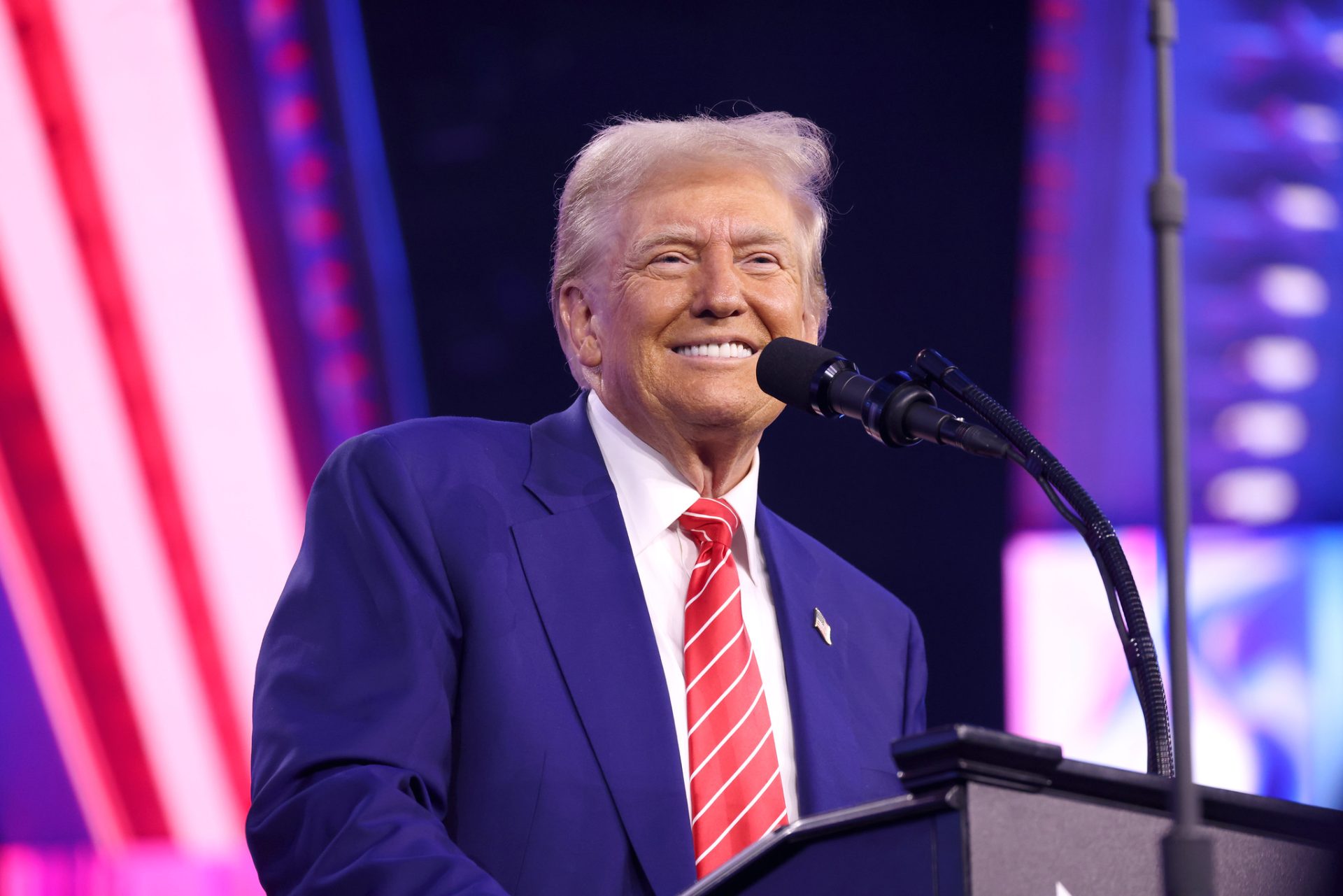
Trump is calling for a far more openly belligerent and bellicose imperialist policy for America’s immediate surroundings, rather than spending money defending the interests of other countries. This explains why Trump is pursuing the idea of annexing Greenland and Canada and also why he wants to retake the Panama Canal. This is what “Make America Great Again” ultimately means.
When Trump looks at Canada, he doesn’t see a loyal and useful junior partner to U.S. imperialism. He just sees yet another country riding the coattails of the United States. Trump sees that most of Canada’s economy is integrated with the American economy and thinks: “Most of that is really ours anyway, and they’re making money off it! Why don’t we just take it?”
But this is a dangerous game. By trying to maintain the American position on the world stage by forcefully asserting its interests even against its traditional allies, Trump risks alienating them, and thereby weakening the U.S. position further. If the loyalty of America’s closest ally is rewarded by such aggression, the message is clear: nobody’s safe.
Crisis of overproduction
The other explanation for Trump’s aggressiveness towards Canada is more directly economic. During the period from the 2008 economic crisis to the COVID crisis, governments across the world resorted to their traditional tricks to save the economy: Keynesian deficit spending, low interest rates, and money printing. Now, they’re out of ammo. Governments are massively indebted, inflation hasn’t been reined in, and the economy is still struggling.
Their last trick is to try to export the crisis through protectionism. This is what Trump’s tariffs on Canada amount to. The U.S. was already waging a trade war against China and has taken protectionist measures against Europe.
The Canadian ruling class naïvely thought they were safe from U.S. protectionism. What they are finding out is what Henry Kissinger said long ago: “America has no permanent friends or enemies, only interests.”
After the Second World War, Canadian capitalism became deeply integrated with the economy of the United States. When capitalism was in a better state, the U.S. was able to guarantee its interests in Canada through “normal” means, i.e. purchasing goods on the market and through various bilateral trade agreements. The Canadian ruling class was more than happy to oblige. They had easy access to the biggest market in the world and they were able to ride the coattails of the most powerful country on Earth.
But as the conflict between the United States and its main global competitors ramps up, the Trump wing of the American ruling class now sees economic integration with Canada as a potential problem.
In Trump’s eyes this is partly because of the trade deficit. Trump has consistently denounced the U.S. trade deficit with Canada, which through the lens of “America First” he describes as a “subsidy”.
Trump and the MAGA wing of the American ruling class resents the consequences of globalization. They resent the loss of the manufacturing and economic power of the United States and they feel that other countries, including Canada, are taking advantage of them.
They resent the fact that since 1975 the U.S. has had an increasing trade deficit with the world, which to them reflects the growing weakness of the United States.
Trump perceives the balance of trade not so much as a measure of economic activity, but as a measure of the balance of power. Simplistically, Trump seems to think that if the U.S. has a surplus trade balance with a trading partner, then the U.S. is “winning” in that relationship and is making money off that country.
There is a certain logic to this. At the root of the economic crisis lies what Marx called the crisis of overproduction: the exploitation of workers by capitalists means the workers cannot buy back the entirety of the value that they produce. In other words, under capitalism, productive capacity always outpaces demand. There is too much being produced to be absorbed by the market. The capitalist ruling class of every country try to overcome this contradiction through export, amongst other tools, which allows them to tap into the market of other countries. When this contradiction becomes untenable and crisis hits, they all wage trade wars against each other to force their commodities on other markets, and protect their markets from other countries. In other words, every country tries to export the crisis.
This is basically what Trump means when he says he no longer wants to “subsidize” Canada. At the head of the most powerful economy on the planet, he wants to leverage that economic might to end the U.S.’ trade deficit. For instance, he said that the integration of the Canadian and American automobile industries had meant that jobs had left the U.S. for Canada, and that he would rather have these vehicles manufactured in Detroit. He wants to repatriate these jobs from Canada to the U.S., thus importing employment and exporting unemployment.
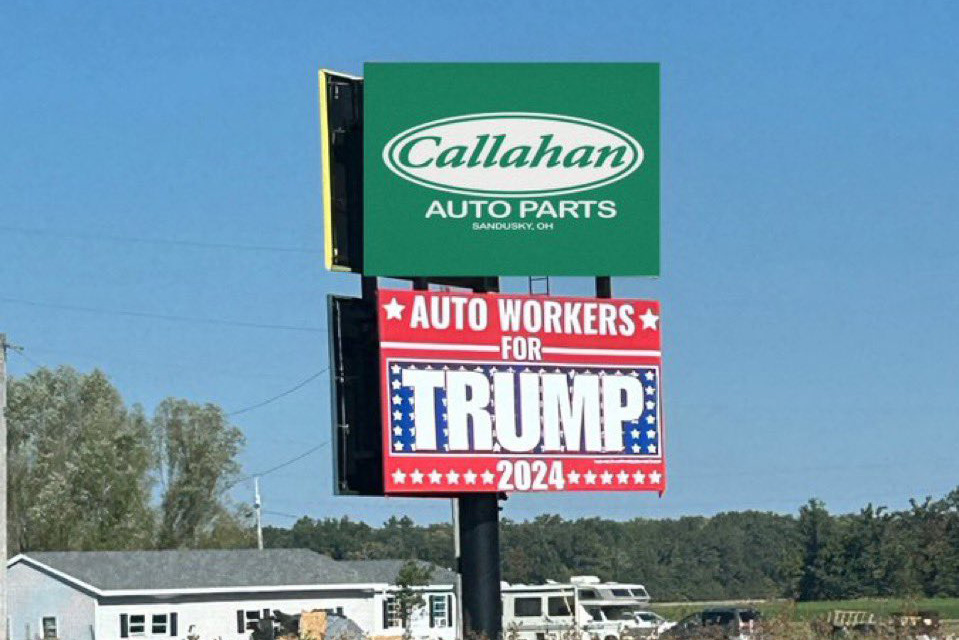
But things are not so simple. Trump’s “America First” approach to U.S. trade relations will only take him so far. The United States has a trade deficit with most of its trading partners. To reverse trade deficits with these countries, the United States would need to massively develop its manufacturing sector.
Trump promised to do just this during his first term as president too, but very little was achieved. That’s because manufacturing goes wherever labour is cheapest.
Manufacturers are not going to return to the United States en masse if they have to pay American wages and operate under stricter regulations, and they haven’t. The only way the United States could once again become the manufacturing centre of the world as it was in the 1950s and 1960s, is if the rights of the working class are smashed and there is a massive reduction in the level of wages and living standards. But this is the opposite of what Trump has promised.
The looming crisis
The Canadian ruling class now finds itself in a bind.
Until very recently, the Canadian capitalists benefitted from a uniquely privileged position in history, as the beneficiary of the world’s largest and most powerful empires. It took advantage of the political, military and economic protection provided by the British Empire, and then the U.S., to develop Canada into a minor imperialist power.
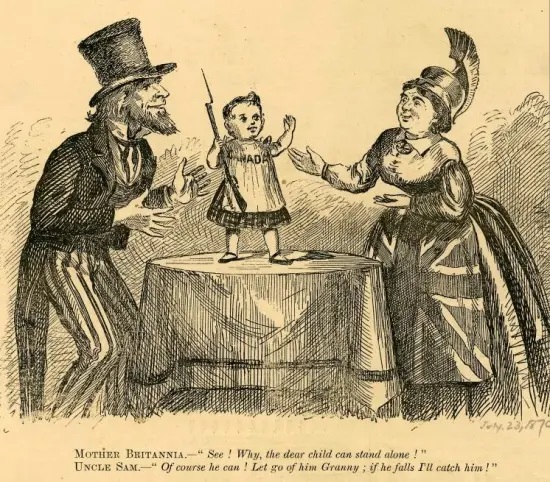
Throughout the Cold War and the decades following, U.S. imperialism was content with its “special relationship” with the Canadian ruling class. But Trump and his MAGA cronies are sick of the Canadian ruling class riding its coattails. At the very least, they want to impose more direct political and economic dominance over Canada.
It is impossible to know exactly what is going to happen. But there are some things we do know that can help us to prepare for future events.
The first is the sheer power of the United States of America in relation to Canada. Look at what has already happened. Trump, before he has even officially assumed office, has played a role in toppling the Trudeau government.
Trump threatened tariffs and then annexation and has had a string of federal and provincial officials rushing to Florida to meet with him, pleading with him not implement the tariffs that will, in Trudeau’s words, “kill the Canadian economy.”
This is really where the power of the United States lies—in its massive economic dominance. The Canadian and American economies are highly interconnected, and the relationship is extremely lopsided in favour of the United States. Some 77 per cent of Canada’s total exports go to the United States, and 63 per cent of its imports come from the U.S. Though Canada is one of the largest exports markets for the U.S., exports to Canada amount to only 17 per cent of total U.S. exports and Canadian goods represent 13.5 per cent of its imports.
A trade war between the United States and Canada would have a disastrous effect for the economies of both countries. The working class will suffer the most because tariffs will have an inflationary effect and unemployment will soar.
When Trump was asked about possible Canadian retaliation, he blustered and said, “We don’t need anything from them.” This is debatable, at least in the short term, since there are a number of Canadian goods that the U.S. currently relies on. But the fact of the matter is that Trump’s proposed tariffs will have a much bigger impact on the Canadian economy, immediately triggering a recession leading to hundreds of thousands of jobs lost.
Oil and energy exports combined with motor vehicles make up around 40 per cent of Canadian exports to the U.S. Tariffs would be devastating for the economies of B.C. (coal, wood), Alberta (oil), Ontario (motor vehicles and parts) as well as Quebec (aluminum and aerospace).
The United States’ and Canada’s automobile industries are fully integrated, and automobile parts often cross the border multiple times before a vehicle makes it to market. Despite what Trump says, it is unlikely that new manufacturing plants and supply chains could be organized in the United States in the short term to replace Canadian imports. This would lead to shortages, inflate the price of vehicles, and could even completely disrupt the automobile industry in the United States.
But the Canadian economy would be hit much harder. Some 93 per cent of Canada’s automobile exports go to the United States, and is the top export of Ontario, Canada’s largest provincial economy.
In the case of oil, the United States is the world’s largest producer of petroleum products and is a net oil exporter. Alberta is Canada’s largest producer of oil, and around 87 per cent of the province’s oil production is exported to the United States.
The United States does need Canadian oil, again at least in the short term, as Canada supplies upwards of 60 per cent of imported heavy crude to the U.S. However, the U.S. would be able to find other sources of heavy crude—from the Middle East, Russia or Venezuela. This might prove problematic for the Trump regime politically, and importing oil from farther afield would also create other problems. But if it absolutely had to, the United States could find other sources of heavy crude.
This wouldn’t be the case for the oil barons in Alberta though. Even if they could find a market that could replace the exports that usually go to the United States, which is unlikely, Albertan oil gets to market via American pipelines.
One Canadian resource that the Americans do rely on is lumber and paper products. In 2023 Canada exported $7.5 billion worth of lumber, which is critical to the U.S. building industry. Canada also supplies around 50-60 per cent of newsprint used in the U.S. Trump has said that Canadian lumber supply could be replaced with a home-grown industry. The U.S. would eventually be able to replace the supply of lumber, but new mills would need to be constructed and new supply chains would need to be organized. This would cause serious pain for the U.S. economy, but would not be nearly as devastating as it would be for Canada, whose lumber industry is geared towards export to the U.S.
The bottom line is that Trump is prepared to flex the economic might of the United States to protect American industries and export unemployment. Trump has all the leverage in this situation, and the Canadian ruling class has very little. The United States could take measures that would truly decimate the Canadian economy. Any retaliatory measures taken by Canada would hurt the United States, but in the long run would hurt the Canadian economy more.
Wither the confederation?
While Trump has ruled out military force, he has said he would use economic force to annex Canada. But even if Trump were to use such economic force that it caused a total collapse of the Canadian economy, how would annexation take place? Under what scenario would the Canadian ruling class submit to the United States and give up its ownership of a sovereign nation?
The American and Canadian ruling classes are separate entities, with their own interests. These interests often align, but not always. The Canadian capitalists knew they could never directly compete with U.S. imperialism in a whole number of spheres, so instead they acted as junior partners. But when opportunities arose to move into areas where the U.S. did not have much of a presence, the Canadian ruling class pursued its own course—to the ire of the United States. Such was the case with Canada’s relations with the Soviet Union, Cuba, and China for example.
It is therefore difficult to imagine the annexation of Canada as a whole in one fell swoop. On the contrary, it is likely that in the coming period, we will see a revival of Canadian nationalism, as the ruling class cynically tries to rally the population behind the defense of their own interests. The working class should not fall for this hypocritical flag-waving from bandits complaining that their share of the loot is shrinking.
That being said, the Canadian Confederation is fraught with contradictions and the Canadian national identity is weak, and not just because of the Quebec national question. The economic basis of the Canadian nation is astonishingly weak. Two facts highlight this very concretely: first, each Canadian province trades more with the United States than with other provinces; second, the economic integration between provinces is extremely underdeveloped, with more trade barriers between provinces than there are between European countries.
Every province thus feels a powerful economic pull to the south. The percentage of exports from the provinces to the U.S. shows just how dependent the Canadian economy is:
| Province | Exports to the U.S. as a percentage of total exports |
| British Columbia | 57.0% |
| Alberta | 89.6% |
| Saskatchewan | 55.7% |
| Manitoba | 74.4% |
| Ontario | 85.0% |
| Quebec | 73.9% |
| New Brunswick | 93.3% |
| Nova Scotia | 65.3% |
| Prince Edward Island | 74.4% |
| Newfoundland and Labrador | 45.8% |
The provinces physically engage in foreign trade, but it is the federal government that has jurisdiction over the regulation of trade and commerce. There has been an eternal conflict between the provinces and the federal government over control of provincial resources and what exactly that means. Faced with Trump’s threats and the possibility of a severe economic crisis, this conflict now becomes a powder keg that could blow up Canadian Confederation.
This was highlighted by the immediate scramble by every provincial leader to propose their own solution or raise their own threats of retaliation when Trump announced his tariffs. Alberta premier Danielle Smith even went to see Trump in Florida, while Parti Quebecois leader Paul St-Pierre Plamondon called on Quebec premier Legault to not wait for the federal government and do the same.
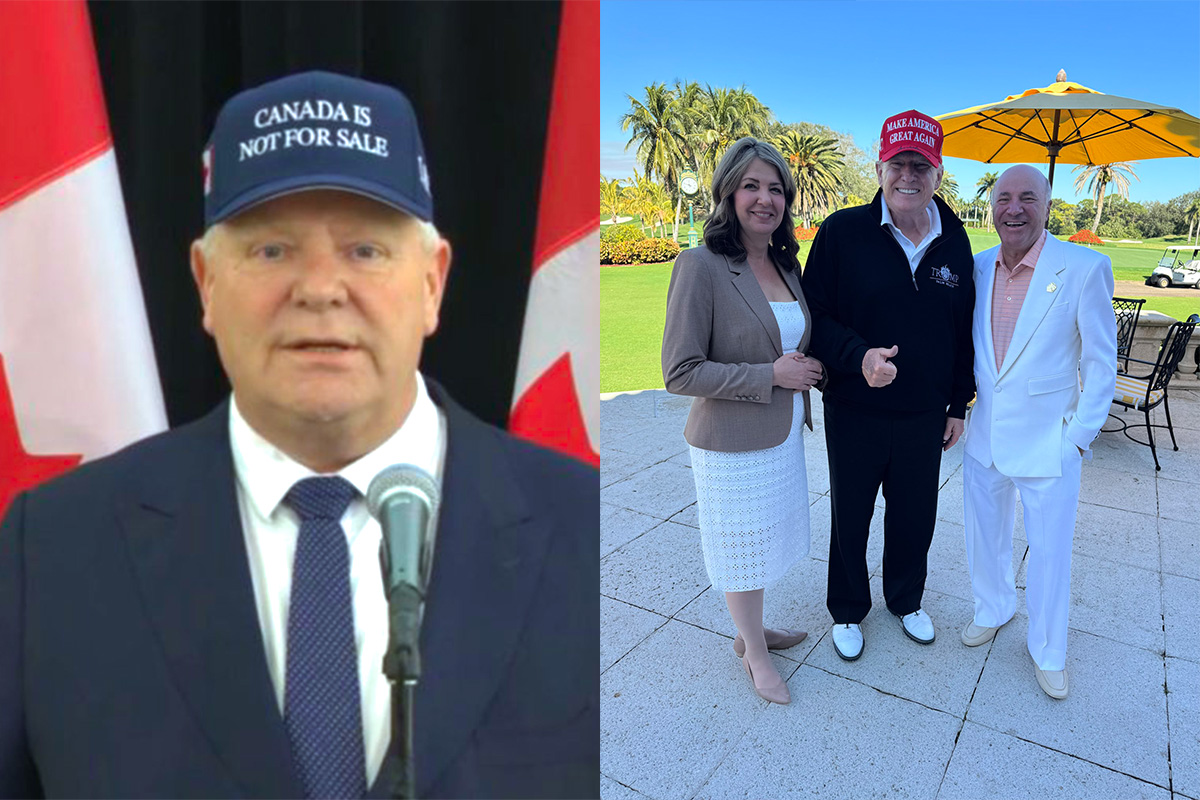
Already, we can see tensions between provinces being exacerbated. While Ontario’s Doug Ford proposed cutting off the U.S. from Canadian energy, this provoked the ire of Alberta’s Smith. Trump’s 25 per cent tariff would be devastating to the province’s oil industry. As a result, Smith is opposed to any retaliatory measures the federal government takes that would further affect the sale of oil and gas to the United States. Smith has openly said that if the federal government imposes an export ban on Alberta oil to the U.S., it would provoke a national unity crisis. And indeed, she was the only premier who refused to sign the statement produced by an emergency meeting of premiers, specifically because she wants to take oil off the table.
While separatist sentiments in Alberta are not as high today as they were a few years ago, hatred for Trudeau’s federal government is as high as ever. If Ottawa is perceived to be encroaching on Alberta’s oil industry and enacts a ban on the export of oil to the United States, there could be a sharp rise in separatist sentiments immediately following the sharp uptick in unemployment. Alberta is already the province where support for joining the United States is highest at 19 per cent, according to a Leger poll from December.
The fact is that many Canadian industries cannot survive without trade with the United States. If the trade war between the United States and Canada is severe enough, each province could independently try to come to a resolution with the United States to save their own industries and economies, such as Alberta trying to get an exemption for its oil exports or Ontario seeking exemptions for auto parts.
Therefore, in the event of a collapse of the Canadian economy, one could well imagine the breakdown of Canada’s increasingly strained Confederation and the eventual piecemeal annexation of one or several provinces.
Class struggle
Last December, an Angus Reid poll asked whether people think Canada should join the United States. Only six per cent were in favour. It seems that Donald Trump’s claim that “many Canadians want Canada to become the 51st state” is simply not true.
However, in response to the statement “I am attached to Canada but only as long as it provides a good standard of living,” 37 per cent of respondents agreed.
This shows that, under the right circumstances, hardships imposed by the United States could result in significant support for Canada joining the United States. If the Canadian economy collapses, so too will living standards—and this could happen surprisingly quickly. Canadians could see joining the U.S. as the only alternative.
But this also indicates other possibilities besides total submission or annexation to the United States. It is also possible that people would come to resent Trump and the United States for imposing economic hardship in the first place. Would people willingly be annexed by a country that had just starved them into submission?
Moreover, a collapse of the Canadian economy would lead to massive unemployment and social unrest. But what would social unrest look like in these circumstances? It would mean mass strikes and protests by the working class for jobs, expanded social services, and a real solution to the crisis, etc. This would mean a period of intense class struggle.
The Canadian ruling class has already proven itself incapable of solving the economic crisis and will prove incapable of dealing with Trump’s tariffs and threats. Under the circumstances of economic collapse and the threat of U.S. annexation, it is entirely possible that the Canadian working class would begin to seek revolutionary solutions to the crisis, opening up the possibility of a period of revolutionary struggle.
At the very least, this would mean that joining the United States would not be the only alternative to the collapse of the Canadian economy. Under these circumstances, socialist revolution could also become a real alternative.
On the basis of capitalism, there is no real solution to the crisis of the Canadian economy or the threat of annexation by the United States. If Trump follows through with his threats, if there is an escalation of the trade war, if he really wants to annex Canada through economic force, then there will be an historic crisis of the Canadian economy and nation state.
For now, the federal government has announced that it will retaliate with “tit-for-tat” tariffs. But the Canadian economy will not be able to withstand the might of the U.S. The only way out for the Canadian ruling class will be to submit one way or another to the dictates of U.S. imperialism.
Either way, the capitalists will transfer the cost of these attacks to the workers. We have to expect price hikes, attacks on unions, wages and working conditions, as well as cuts to environmental regulation and social spending. Already, they have bent to U.S. dictates by increasing spending on border “security” and the military—billions of dollars that will be paid for by cuts in social services.
In other words, it’s the Canadian working class that will be made to pay for the crisis of U.S. imperialism. Our ruling class will not protect us.
Our only ally in this situation will be the American working class. Trump’s stated plan of annexing Canada is totally reactionary. Trump won the election largely as a result of his promise to fix the problems of high prices and unemployment. But this trade war with Canada will not solve these problems, on the contrary it will most likely make them worse. The working class on both sides of the border must avoid the trap of supporting their own national capitalist class against that of the other.
The working class of Canada and the United States must stand together and fight for their common class interests against those of the capitalists on both sides of the border who have only brought them to the brink of ruin. United, the working class of the U.S. and Canada could stop Trump in his tracks and wage a common struggle across North America to put an end to this capitalist nightmare.
